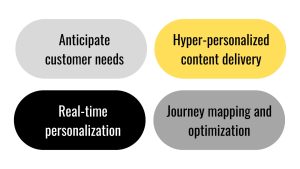Personalization 3.0: How AI is Powering Predictive Customer Journeys
Introduction In today’s fast-paced digital world, customer expectations are higher than ever. They want brands to know what they need before they even ask. That’s where Person...

Introduction
In today’s fast-paced digital world, customer expectations are higher than ever. They want brands to know what they need before they even ask. That’s where Personalization 3.0 comes in – a cutting-edge era powered by artificial intelligence (AI) that delivers predictable, seamless customer experiences.
Unlike traditional personalization methods that simply recommend similar products, Personalization 3.0 uses AI to predict customer behavior. It plans the next steps in the customer journey before they even know where they’re going. Let’s explore how Personalisation 3.0 is changing predictive customer journeys and helping companies stay competitive.
What is Personalization 3.0?
Personalization 3.0 goes beyond simple content curation. It doesn’t just show you products based on your browsing history or previous purchases. Instead, it uses machine learning (ML) and big data analytics to predict future needs and preferences.
Think about how Netflix suggests the next exciting TV show to watch before you’ve even finished watching the current one. Or a fitness app that plans your next workout based on your progress and preferences. These predictive capabilities define Personalization 3.0.

Key AI Technologies Driving Personalization 3.0
There are several advanced AI technologies behind this shift:
- Machine learning algorithms: These models analyze large data sets to find patterns and make predictions.
- Natural language processing (NLP): NLP helps AI understand and respond to user queries in a human-like manner.
- Computer vision: This technology identifies visual content preferences for personalized recommendations.
- Predictive analytics: By analyzing past behavior, predictive models predict future actions.
How AI Powers Predictive Customer Journeys
- Anticipate customer needs. AI analyzes customer interactions across all channels to understand preferences. For example, an e-commerce platform can predict when a customer is running low on an item and send timely offers to restock it.
- Real-time personalization. Gone are the days of static recommendations. AI-powered systems update offers in real time as users interact with the platform. This keeps the experience dynamic and engaging.
- Hyper-personalized content delivery. AI ensures that every touchpoint is tailored to the individual. Personalization becomes clearer and more meaningful, whether it’s email marketing or website content.
- Journey mapping and optimization. AI predicts the most likely customer journey and suggests ways to optimize it. If a user hesitates during checkout, the system can trigger a special offer or send an email reminder to close the sale.

Benefits for Businesses and Customers
For Business:
- Higher Conversions: Relevant recommendations lead to more purchases.
- Better Customer Retention: Personalized experiences build loyalty.
- Operational Efficiency: Automated insights reduce the need for manual review.
For Customers:
- Improved Experience: AI cuts through clutter and delivers what users need faster.
- Time Savings: No more sifting through irrelevant products or content.
- Tailored Solutions: Customers receive information, products, or services that truly meet their needs.
Challenges to Overcome
Despite the benefits, there are also barriers:
- Data privacy concerns: Companies must be transparent about how data is collected and used.
- AI bias: Ensuring that AI models are free of bias is critical.
- Integration challenges: Aligning AI with existing systems can be challenging.
Addressing these challenges requires a thoughtful approach to AI implementation and a commitment to the ethical use of data.
Best Practices for Implementing Personalization 3.0
- Start small: Test AI solutions on a smaller scale before full implementation.
- Use data ethically: Ensure compliance with data privacy regulations like GDPR.
- Collaborate across teams: Align marketing, sales, and IT to seamlessly integrate AI.
- Monitor performance: Continuously evaluate the effectiveness of your AI-powered personalization efforts.

Conclusion
Personalization 3.0 is just the beginning. As AI becomes more sophisticated, predictive customer journeys will become even more accurate and intuitive. Technologies like generative AI will further enhance personalization, creating highly customized experiences.
By harnessing the power of AI, companies can create predictive customer journeys that feel natural and intuitive. Meanwhile, customers enjoy seamless, customized experiences that meet their needs before they even formulate them.
Now is the time for forward-thinking companies to embrace this transformative approach. Personalization 3.0 isn’t just the future, it’s happening now. Will your business keep up?